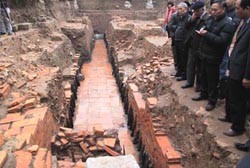(VOVworld) – ‘Imposing’ was the word Professor Phan Huy Le, Chairman of the Vietnam Association of Historical Sciences, used to describe the newly unearthed architectural work in Thang Long Imperial Citadel in Hanoi. The Vietnamese historian said this was a water system of the Ly Dynasty, the first of its kind to have been excavated in the country. VOV’s Phuong Anh introduces this special architecture.
 |
| One thousand years of history: Traces of an ancient and huge water project and parallel ground wall from the time of the Ly Dynasty have been found at the centre of Thang Long Imperial Citadel in Ha Noi. — VNS Photo Mai Anh |
The water system is still being studied. But clues have already convinced a majority of archaeologists and historians that it dates back to the Ly dynasty between the 11 and 13th centuries. The water system was discovered at the Kinh Thien Palace – Doan Mon (Southern Gate) site during an excavation of the Thang Long Citadel from last June to last December. The 500-square- meter, 4.2m deep excavation site is at the very centre of the Thang Long – Hanoi axis. According to the archaeologists, square and rectangular bricks and timber poles aligned in an east-west direction were intertwined and overlapped almost a thousand years ago. Their color appears unchanged. Tong Trung Tin, head of the Vietnam Institute of Archaeology, says ‘We’ve studied the material and the style of the bricks and found that they belonged to the Ly Dynasty. This means the work was done under the Ly Dynasty. All are red bricks, with walls at the two sides carved with Chinese characters. Square bricks were used for the bottom layer with timber poles on the two sides for support. This means the water drainage was carefully built, reflecting the design and construction expertise of the people of the Ly dynasty.’
Nguyen Van Son, Director of the Thang Long Cultural Heritage Preservation Center, has this to say ‘The water works of the Ly dynasty will help us prove that the Kinh Thien Palace area was the central axis of the Thang Long Forbidden City under the Ly and Tran Dynasties. We have always defended this hypothesis, but in recent years many Japanese scholars and some from the Vietnam Social Science Institute have said that the center of the Thang Long Forbidden City was at 18 Hoang Dieu Street, especially following the excavation of that area.’
Also found at the North Gate site were relics from the Tran, Early Le, and Nguyen dynasties. Mr. Tin comments ‘A cultural layer of the Tran dynasty was found right above the one of the Ly dynasty. It included waterways, water tanks, tunnels, foundation buttresses, and brick foundations. The vestiges were built one over the other and may have existed for a thousand years from the Ly to the later Nguyen Dynasty. Until the Le dynasty, vestiges of the peculiar structure for kings only were discovered between the Southern Gate and the center of Kinh Thien Palace.’
Nguyen Van Son, Director of the Thang Long Cultural Heritage Preservation Center, says ‘This is a new discovery. Soon, we will open it to the public. Preservation is time-consuming work and it’ll take a long time to study and expand the excavation site to obtain an overview and clarify the functions of the water system. Measures to preserve the work from further damage will be applied first.’
Lan Anh - Le Phuong